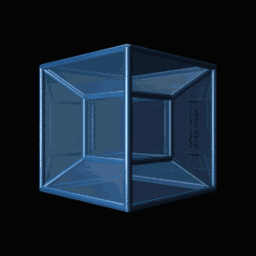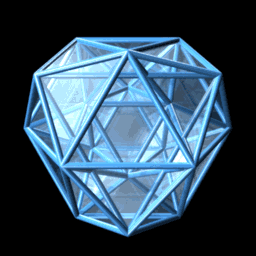
An adventure to the unknown!
 Physicists work under the assumption that there are at least 10 dimensions, but the majority of us will never "see" them. Because we only know life in 3-D, our brains don't understand how to look for anything more.
Physicists work under the assumption that there are at least 10 dimensions, but the majority of us will never "see" them. Because we only know life in 3-D, our brains don't understand how to look for anything more.In 1884, Edwin A. Abbot published a novel that depicts the problem of seeing dimensions beyond your own. In "Flatland: A Romance of Many Dimensions," Abbot describes the life of a square in a two-dimensional world. Living in 2-D means that the square is surrounded by circles, triangles and rectangles, but all the square sees are other lines. One day, the square is visited by a sphere. On first glance, the sphere just looks like a circle to the square, and the square can't comprehend what the sphere means when he explains 3-D objects. Eventually, the sphere takes the square to the 3-D world, and the square understands. He sees not just lines, but entire shapes that have depth. Emboldened, the square asks the sphere what exists beyond the 3-D world; the sphere is appalled. The sphere can't comprehend a world beyond this, and in this way, stands in for the reader. Our brains aren't trained to see anything other than our world, and it will likely take something from another dimension to make us understand.
But what is this other dimension? Mystics used to see it as a place where spirits lived, since they weren't bound by our earthly rules. In his theory of special relativity, Einstein called the fourth dimension time, but noted that time is inseparable from space. Science fiction aficionados may recognize that union as space-time, and indeed, the idea of a space-time continuum has been popularized by science fiction writers for centuries [source: Overbye]. Einstein described gravity as a bend in space-time. Today, some physicists describe the fourth dimension as any space that's perpendicular to a cube -- the problem being that most of us can't visualize something that is perpendicular to a cube [source: Cole].
Researchers have used Einstein's ideas to determine whether we can travel through time. While we can move in any direction in our 3-D world, we can only move forward in time. Thus, traveling to the past has been deemed near-impossible, though some researchers still hold out hope for finding wormholes that connect to different sections of space-time [source: Goudarzi].
If we can't use the fourth dimension to time travel, and if we can't even see the fourth dimension, then what's the point of knowing about it? Understanding these higher dimensions is of importance to mathematicians and physicists because it helps them understand the world. String theory, for example, relies upon at least 10 dimensions to remain viable [source: Groleau]. For these researchers, the answers to complex problems in the 3-D world may be found in the next dimension -- and beyond
Check this!
Have you ever considered how a four-dimensional being would appear to you if it suddenly came into your room?
I think they would resemble flesh-colored balloons constantly changing in size. We would see disconnected blobs of flesh, some attached to claws, teeth, lips, eyes, or hair. Let me tell you why.
Think of it this way. Consider a two-dimensional world resembling a sheet of paper. How would you appear to the inhabitants of such a world if you tried to interact with with them? The 2-D creatures would only see cross-sections of you as you intersected their universe. Your finger would look like a flat disc that grew in size as you pushed it through their world.
Your five fingers might looked like five separate circles. They would just see irregular shapes with skin boundaries as you entered their world. Similarly, a hyperbeing who lived in the fourth dimension would have a cross-section in our space that looked liked a bunch of skin blobs.
A 4-D being would be a god to us. It would see everything in our world. It could even look inside your stomach and remove your breakfast without cutting through your skin, just like you could remove a dot inside a circle by moving it up into the third dimension, perpendicular to the circle, without breaking the circle.
A hyperbeing can effortlessly remove things before your very eyes, giving you the impression that the objects simply disappeared. The hyperbeing can also see inside any 3-D object or life form, and if necessary remove anything from inside. The being can look inside our intestines, or remove a tumor from our brain without ever cutting through the skin. A pair of gloves can be easily transformed into two left or two right gloves. And 3-D knots fall apart in the hands of a hyperbeing, much as a 2-D knot (a loop of string lying on a plane) can easily be undone by a 3-D being simply by lifting the end of the loop up into the third dimension.
What Do You Think?
Find out all about the fourth dimension in my book Surfing Through Hyperspace: Understanding Higher Universes in Six Easy Lessons (Oxford University Press).Click here for more information on this book. In the book, I answer such questions as: 1. What would a being who could move in the fourth spatial dimension look like to us? Would these beings have teeth? If these beings evolved just like us, how would they look to us? Would they have internal organs like our own?
2. Would the beings look liked bags of skin or be more exotic?
3. What are the chances that we could learn to communicate at all with a 4-D extraterrestrial?
4. As a consequence of their access to a fourth dimension, what powers would seemingly amazing powers would they have? What would their sex acts be like? How might they think and act? How might we search for them?
5. If we encountered them, we would find they can perform levitation, bloodless surgery, disappear in front of our eyes, walk through walls. Nothing would be hidden from them, no matter how hard we tried to hide. Certainly if such a being was observed in biblical times, He would be considered a God with many characteristics of omniscience, omnipresence, omnipotence. How would an encounter today affect our world and religion? What is the religious significance?
6. Could God be a four-dimensional being?
7. Would we be able to hear the speech of a 4-D being inches away in the fourth dimension? How would sound work? What would the being sound like using 4-D vocal cords? What happens to photons in four dimesions? For example, how do 4-D beings see? We don't seem to be "losing" photons into the fourth dimension, so I'm not clear how 4-D creatures would use them to see us or themselves...
Some Random Thoughts
Is it hard to imagine a universe with four dimensions in which we are constrained to 3 dimensions? Could there be some mechanism constraining us -- such as being stuck to a surface via adsorption? If we were stuck to some surface in this manner, then the way free 4-D beings could interact with us would be constrained by that surface. In our 3-D world, evolutionary mechanisms made us evolve into
tubes. The earliest multi-celled sea creatures were tubes that could
pump water through and pick up nutrients from the water as it went by.
As life evolved, the primary structural differences involved the
complexity of organs attached to the tube. We are still just tubes,
but we carry a lot of that ancient sea around with us in the "inside"
of a bag.
In our 3-D world, evolutionary mechanisms made us evolve into
tubes. The earliest multi-celled sea creatures were tubes that could
pump water through and pick up nutrients from the water as it went by.
As life evolved, the primary structural differences involved the
complexity of organs attached to the tube. We are still just tubes,
but we carry a lot of that ancient sea around with us in the "inside"
of a bag.In higher dimensions, the fraction of volume near the surface of a baglike form increases dramatically compared to 3-D forms. Heat dissipation and movement of nutrients and oxygen (most of the blood vessels uniformly distributed through the bag will be close to the surface too) may be strongly affected by the proximity of the volume to surface. How would this affect the evolution of life? Would primitive 4-D beings may evolve so that they digest on the outer surface, with other organs, like brains and hearts not involved with nutrient an oxygen acquisition, deep inside? The outer surface would be digestive and pulmonary, and contain sense organs and orifices for excretion and sex. Is this tendency more likely as the dimension of the space increased?
Here is why the volume of a 4-D animal is more concentrated near the surface than 3-D animal volumes. Consider a D-dimensional sphere. The volume is
V(R) = S(D)*R**D / D.
where S is the solid angle in dimension D, and R the radius.
If you compare two spheres of radius 1 and 1 - a, where a is very small, the difference is
(V(1) - V(1 - a)) / V(1) = 1 - (1 - a)**D.
This is essentially the fraction of the volume within 1-a of the surface. Particularly, if you have a 10-dimensional sphere, then about 40% of the volume is within 0.05 R of the surface (a = 0.05). In a 4 dimensional sphere, about 34% of the volume is within 0.1R of the surface. In a 3D sphere, this is 27%. For that D=10 sphere, the fraction within 0.1R is 65%.



0 Comments::
Post a Comment
Hope you enjoyed :)